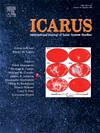Quantifying lava surface heterogeneity on Mars using THEMIS brightness temperature data
IF 2.5
2区 物理与天体物理
Q2 ASTRONOMY & ASTROPHYSICS
引用次数: 0
Abstract
The analysis and characterization of any planetary surface relies heavily on orbital data. The Martian surface is dominated by extrusive volcanism with most of the younger rocks being either too rough or at altitudes that are commonly inaccessible to landers or rovers. Therefore, the accurate interpretation of orbital data is critical to understanding the planet's youngest magmatic conditions and subsequent cratering and eolian history. However, the cumulative effects of surface processes such as dust deposition spanning millions of years typically obscures observable features, posing challenges for data analysis. This study focuses on the igneous terrains from Arsia Mons and into Daedalia Planum using a unique off-nadir thermal infrared (TIR) dataset acquired through special tasking of the Mars Odyssey spacecraft. Prior studies of this region indicated compositional variations were present, yet the dust cover made conclusive results impossible. This study introduces a novel methodology that combines the KRC thermal model, quantitative thermal inertia data, and the off-axis TIR observations to predict surface temperature and quantify submeter-scale surface roughness. In doing so, we reveal changes in lava flow roughness that can be correlated to relative flow ages, flow dynamics, and preferential mantling of dust. These data are compared to older, nadir pointing, THEMIS emissivity data to quantify the anisothermality caused by surface roughness. The results underscore the significance of existing orbital data acquired and processed in novel ways to retrieve new information about Martian volcanology and the ongoing dynamics acting on these surfaces.
求助全文
约1分钟内获得全文
求助全文
来源期刊

Icarus
地学天文-天文与天体物理
CiteScore
6.30
自引率
18.80%
发文量
356
审稿时长
2-4 weeks
期刊介绍:
Icarus is devoted to the publication of original contributions in the field of Solar System studies. Manuscripts reporting the results of new research - observational, experimental, or theoretical - concerning the astronomy, geology, meteorology, physics, chemistry, biology, and other scientific aspects of our Solar System or extrasolar systems are welcome. The journal generally does not publish papers devoted exclusively to the Sun, the Earth, celestial mechanics, meteoritics, or astrophysics. Icarus does not publish papers that provide "improved" versions of Bode''s law, or other numerical relations, without a sound physical basis. Icarus does not publish meeting announcements or general notices. Reviews, historical papers, and manuscripts describing spacecraft instrumentation may be considered, but only with prior approval of the editor. An entire issue of the journal is occasionally devoted to a single subject, usually arising from a conference on the same topic. The language of publication is English. American or British usage is accepted, but not a mixture of these.
 求助内容:
求助内容: 应助结果提醒方式:
应助结果提醒方式:


